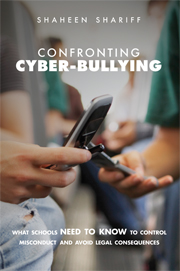 Confronting Cyber-Bullying
Confronting Cyber-Bullying Book contents
- Frontmatter
- Contents
- Figures
- Tables
- Preface
- Acknowledgments
- 1 Cyber Misconduct: Who Is Lord of the Bullies?
- 2 Profile of Traditional and Cyber-Bullying
- 3 Cyber Libel or Criminal Harassment: When Do Kids Cross the Line?
- 4 Student Free Expression: Do the Schoolhouse Gates Extend to Cyberspace?
- 5 Fostering Positive School Environments: Physical and Virtual
- 6 Censoring Cyberspace: Can Kids Be Controlled?
- 7 The Tragedy of the Commons: Lessons for Cyberspace?
- 8 Cyber Collaboration: Models for Critical Legal Pluralism in Teacher Education Programs
- Notes
- Cases
- Index
- References
6 - Censoring Cyberspace: Can Kids Be Controlled?
Published online by Cambridge University Press: 02 July 2009
- Frontmatter
- Contents
- Figures
- Tables
- Preface
- Acknowledgments
- 1 Cyber Misconduct: Who Is Lord of the Bullies?
- 2 Profile of Traditional and Cyber-Bullying
- 3 Cyber Libel or Criminal Harassment: When Do Kids Cross the Line?
- 4 Student Free Expression: Do the Schoolhouse Gates Extend to Cyberspace?
- 5 Fostering Positive School Environments: Physical and Virtual
- 6 Censoring Cyberspace: Can Kids Be Controlled?
- 7 The Tragedy of the Commons: Lessons for Cyberspace?
- 8 Cyber Collaboration: Models for Critical Legal Pluralism in Teacher Education Programs
- Notes
- Cases
- Index
- References
Summary
Bullying using a new information technology … gives kids way more power than they've had.
(School superintendent Anne Kerr, as quoted in Girard & Nguyen, 2007)INTRODUCTION
School authorities look for ways to control online expression that defames or insults peers and teachers, believing it has become completely out of control. Is this really the case? Why is there such a fear among school officials that information technologies give students too much power? This chapter looks at ways in which school stakeholders influence the development and implementation of censorship laws that are designed to control not only what students express but also what they learn on a regular basis. The concern among school officials that information technology gives students too much power is grounded in the fear that technology can also change knowledge production and control of that knowledge production. As a result, the normative role of schools is challenged and compromised. Consequently, educators look for legal options grounded in positivistic responses, such as criminal law, legislation that forces schools and libraries to filter certain programs (Deleting Online Predators Act, 2006), and zero-tolerance policies rooted in military models of discipline (Skiba & Peterson, 1999). Yet as we have seen in earlier chapters, students are raising substantive legal defenses, grounded in fundamental principles of justice.
- Type
- Chapter
- Information
- Confronting Cyber-BullyingWhat Schools Need to Know to Control Misconduct and Avoid Legal Consequences, pp. 159 - 189Publisher: Cambridge University PressPrint publication year: 2009


